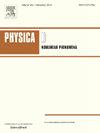Resource-consumer dynamics in drylands: Modeling the role of plant–plant facilitation–competition shifts with a piecewise system
IF 2.7
3区 数学
Q1 MATHEMATICS, APPLIED
引用次数: 0
Abstract
In drylands, water availability determines plant population densities and whether they cooperate via facilitation or compete. When water scarcity intensifies, plant densities decrease and competition for water surpasses the benefits of soil improvement by facilitator plants, involving an abrupt shift from facilitation to competition. Here, we model this facilitation–competition shift using a piecewise system in a resource species such as grasses studying its impact on a resource-consumer dynamical system. First, the dynamics of each system i.e., competitive and cooperative, are introduced separately for this resource-consumer system. The competitive system, by setting conditions to have a monodromic equilibrium in the first quadrant, has no limit cycles. With a monodromy condition in the same quadrant, the cooperative system only has a hyperbolic, small amplitude limit cycle, allowing for an oscillating coexistence. The dynamic properties of the piecewise system become richer. We here prove the extension of the center-focus problem in this particular case, and from a weak focus of order three, we find 3 limit cycles arising from it. We also study the case assuming continuity in the piecewise system. Finally, we present a special and restricted way of obtaining a limit cycle of small amplitude in a pseudo-Hopf bifurcation type. Our results suggest that abrupt density-dependent functional shifts, such as those described in drylands, could introduce novel dynamical phenomena in population dynamis. Our work also provides a novel theoretical framework to model and investigate population dynamics where ecological interactions change due to density-dependent effects.
求助全文
约1分钟内获得全文
求助全文
来源期刊

Physica D: Nonlinear Phenomena
物理-物理:数学物理
CiteScore
7.30
自引率
7.50%
发文量
213
审稿时长
65 days
期刊介绍:
Physica D (Nonlinear Phenomena) publishes research and review articles reporting on experimental and theoretical works, techniques and ideas that advance the understanding of nonlinear phenomena. Topics encompass wave motion in physical, chemical and biological systems; physical or biological phenomena governed by nonlinear field equations, including hydrodynamics and turbulence; pattern formation and cooperative phenomena; instability, bifurcations, chaos, and space-time disorder; integrable/Hamiltonian systems; asymptotic analysis and, more generally, mathematical methods for nonlinear systems.
 求助内容:
求助内容: 应助结果提醒方式:
应助结果提醒方式:


